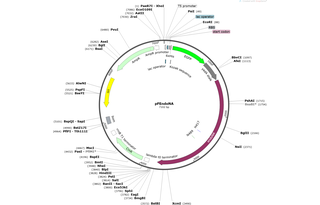pFEndoNA
(Plasmid
#174724)
-
PurposeExpresses GFP-endoNA fusion protein for degradation of polysialic acid. The endoNA is a catalytically active endosialidase from bacteriophage PK1A.
-
Depositing Lab
-
Sequence Information
Ordering
| Item | Catalog # | Description | Quantity | Price (USD) | |
|---|---|---|---|---|---|
| Plasmid | 174724 | Standard format: Plasmid sent in bacteria as agar stab | 1 | $89 | |
Backbone
-
Vector backbonepQE-31
-
Backbone manufacturerQIAGEN
- Backbone size w/o insert (bp) 3463
- Total vector size (bp) 7102
-
Vector typeBacterial Expression
Growth in Bacteria
-
Bacterial Resistance(s)Ampicillin, 100 μg/mL
-
Growth Temperature37°C
-
Growth Strain(s)NEB Stable
-
Copy numberHigh Copy
Gene/Insert
-
Gene/Insert nameGFP-endoNA fusion protein
-
SpeciesAequorea victoria, Yersinia enterocolitica, Escherichia phage PK1A
-
Insert Size (bp)3637
-
GenBank IDU76561.1, X13882.1, EF507428.1
- Promoter T5
-
Tag
/ Fusion Protein
- Histag (N terminal on backbone)
Cloning Information
- Cloning method Restriction Enzyme
- 5′ cloning site BamHI (destroyed during cloning)
- 3′ cloning site BamHI (destroyed during cloning)
- 5′ sequencing primer CCCGAAAAGTGCCACCTG (Common Sequencing Primers)
Resource Information
-
Supplemental Documents
Terms and Licenses
-
Academic/Nonprofit Terms
-
Industry Terms
- Not Available to Industry
Trademarks:
- Zeocin® is an InvivoGen trademark.
Depositor Comments
This plasmid can be amplified and maintained in ampicillin-sensitive E. coli strains that harbor the lacIq mutation (such as XL1 Blue and JM109) or carries the pREP4 repressor plasmid (such as M15 [pREP4]).
These plasmids were created by your colleagues. Please acknowledge the Principal Investigator, cite the article in which the plasmids were described, and include Addgene in the Materials and Methods of your future publications.
-
For your Materials & Methods section:
pFEndoNA was a gift from Jukka Finne (Addgene plasmid # 174724 ; http://n2t.net/addgene:174724 ; RRID:Addgene_174724) -
For your References section:
Construction of antibody mimics from a noncatalytic enzyme-detection of polysialic acid. Jokilammi A, Ollikka P, Korja M, Jakobsson E, Loimaranta V, Haataja S, Hirvonen H, Finne J. J Immunol Methods. 2004 Dec;295(1-2):149-60. doi: 10.1016/j.jim.2004.10.006. Epub 2004 Nov 14. 10.1016/j.jim.2004.10.006 PubMed 15627620





